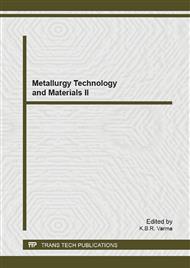p.419
p.427
p.431
p.435
p.443
p.447
p.452
p.456
p.460
Effects of Chloride and Sulphate Ions on the Experimental E-pH Diagrams of AISI 316L Stainless Steel in Deaerated Aqueous Solutions
Abstract:
A cyclic polarisation method was applied to construct the E-pH diagrams of AISI 316L stainless steel in deaearted solutions containing 1000 and 2000 ppm of sodium sulphate without and with 3550 ppm of sodium chloride. Addition of chloride ions to the sulphate solutions caused a region of imperfect passivation regime to appear, and its addition to the 1000-ppm sulphate solution considerably reduced the transpassive potential. Furthermore, the addition of sulphate ions to the 3550-ppm chloride solution enlarged the passivation regime, mainly by shifting the transpassive potentioal to the noble direction. However, the imperfect passivation regime also enlarged by the positive shift of that potential and by reduction of the protection potential. This negative role of sulphate is discussed in comparison with the role of sulphate on accelerating pit growth studied by the critical-pitting-temperature technique reported in literature.
Info:
Periodical:
Pages:
443-446
Citation:
Online since:
September 2013
Keywords:
Price:
Сopyright:
© 2013 Trans Tech Publications Ltd. All Rights Reserved
Share:
Citation:


